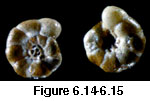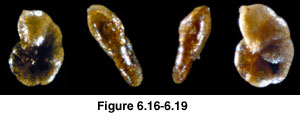 v. 1808 Nautilus inflatus Montagu,
1808, p. 81, pl. 18, fig. 3.
v. 1808 Nautilus inflatus Montagu,
1808, p. 81, pl. 18, fig. 3.
Genus TROCHAMMINA Parker and Jones, 1859
Trochammina inflata (Montagu), 1808
Figure 6.12 and 6.13
 v. 1808 Nautilus inflatus Montagu,
1808, p. 81, pl. 18, fig. 3.
v. 1808 Nautilus inflatus Montagu,
1808, p. 81, pl. 18, fig. 3.
v. 1858 Rotalina inflata (Montagu). Williamson, 1858, p. 50, pl. 4, figs. 93, 94.
v. 1859 Trochammina inflata (Montagu). Parker and Jones, 1859, p. 347. Carpenter et al., 1862, p. 141, pl. 11, fig. 5. Parker, 1952a, p. 459, pl. 3, fig. 1. Parker et al., 1953, p. 15, pl.3, figs. 7, 8. Phleger, 1954, p. 646, pl.3, figs.22, 23. Scott and Medioli, 1980, p. 44, pl. 3, figs. 12-14; pl. 4, figs. 1-3. Boltovskoy, 1984, fig. 13. Scott et al., 1990, p. 733, pl. 1, figs. 3a, b. Scott et al., 1991, p.388, pl. 2, figs. 7,8.
v. 1957 Siphotrochammina lobata Saunders, 1957, p. 9, pl. 3, figs. 1, 2.
v. 1977 Siphotrochammina elegans Zaninetti et al., 1977, pl. 2, figs. 8, 10, 11.
We consider Trochammina inflata and Siphotrochammina inflata to be one species since, in Bermuda mangrove swamps, these species show an intergradation from a Trochammina inflata aperture ("an arched slit at the inner margin of the ventral side of the last chamber", Saunders, 1957, p.9) to Siphotrochammina lobata aperture ("a forward-directed, circular opening at the inner end of a siphon like lobe that extends from the last chamber into the umbilicus", Saunders, 1957, p.9). This suggests that Siphotrochammina morphology is part of the intraspecific variability of Trochammina (Javaux 1999). This intergradation was also observed in Japanese marshes (Scott et al., 1995) and in South Carolina marshes (Collins, 1996).
Some specimens of Trochammina inflata develop a secondary agglutinated tube attached to the aperture, possibly for attachment or to facilitate feeding in a very dense vegetal micro-environment (mangrove peat) (Javaux 1999).
This agglutinated species is one of the most common species of many mangroves and marshes throughout the world, including in Bermuda. It is reported in mangroves of Florida-Bahamas, Trinidad, Brazil, Equator, Columbia, New Zealand, Senegal; in mangroves of Tobago and Sunda Shelf and probably in nearshore waters and lagoons of Venezuela as Trochammina spp.
 v. 1870 Trochammina inflata (Montagu) var. macrescens Brady,
1870, p. 290, pl. 11, fig. 5. Scott, 1976, p. 320, pl. 1, figs. 4-7.
v. 1870 Trochammina inflata (Montagu) var. macrescens Brady,
1870, p. 290, pl. 11, fig. 5. Scott, 1976, p. 320, pl. 1, figs. 4-7.
v. 1938 Jadammina polystoma Bartenstein and Brand, 1938, p. 381, figs. 1, 2.
v. 1952 Trochammina macrescens Brady. Parker, 1952b, p. 460, pl. 3, fig. 3. Parker et al., 1953, P. 15, pl.3, figs. 7, 8. Phleger, 1954, p. 646, pl. 3, fig. 24. Scott and Medioli, 1980, p. 44, pl. 3, figs. 1-12. Scott et al., 1990, p. 732, pl. 1, figs. 1, 2. Scott et al., 1991, p. 388, pl. 2, figs. 10, 11.
 This agglutinated species lives in many temperate marshes, and in Bermuda mangroves and landlocked marine ponds with fringing mangroves. It is also reported in mangroves of the Sunda Shelf, and probably in mangroves of Trinidad and Venezuela as
Trochammina spp. We illustrate the two formae here, f. macrescens and f.
polystoma (after Scott and
Medioli, 1980,); the first forma is the low salinity variant common to most brackish marshes under 20
This agglutinated species lives in many temperate marshes, and in Bermuda mangroves and landlocked marine ponds with fringing mangroves. It is also reported in mangroves of the Sunda Shelf, and probably in mangroves of Trinidad and Venezuela as
Trochammina spp. We illustrate the two formae here, f. macrescens and f.
polystoma (after Scott and
Medioli, 1980,); the first forma is the low salinity variant common to most brackish marshes under 20![]() while the second forma is a higher salinity variant. The low salinity variant is most common in Bermuda.
while the second forma is a higher salinity variant. The low salinity variant is most common in Bermuda.
 v. 1858 Rotalina ochracea Williamson,
1858, p. 55, pl. 4, fig. 112; pl. 5, fig. 113.
v. 1858 Rotalina ochracea Williamson,
1858, p. 55, pl. 4, fig. 112; pl. 5, fig. 113.
v. 1865 Trochammina squamata Parker and Jones, 1865, p. 407, pl. 15, figs. 30, 31. Parker, 1952a, p. 460, pl. 3, fig. 4. Parker, 1952b, p. 408, pl. 4, figs. 11-16. Scott and Medioli, 1980, p. 45, pl. 4, figs. 6,7.
v. 1952 Trochammina squamata Parker and Jones, and related species. Parker, 1952a, p. 460, pl. 3, fig. 5.
v. 1920 Trochammina ochracea (Williamson). Cushman, 1920b, p. 75, pl. 15, fig. 3, Scott and Medioli, 1980, p.45, pl. 4, figs. 4,5.
This delicate agglutinated species is commonly attached to hard substrates in high-energy reefs but was never reported in previous studies of reef foraminifera, although it might be the species called "?Remaneicea sp. cfr. R. Kelletae" by Wantland (1975) for high turbulence areas of the Belize shelf, and "T. squamata" reported by Brasier (1975b) in Barbuda backreefs. T. ochracea is reported usually in cold to temperate waters with high organic content and quiet conditions (e.g. Scott et al., 1980, 1990; Shennan et al., 1999; Collins, 1996). It may have been overlooked in subtropical/tropical turbulent environments due to its small size and attached life habit, and its previously known habitat.